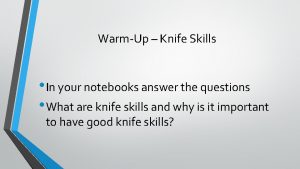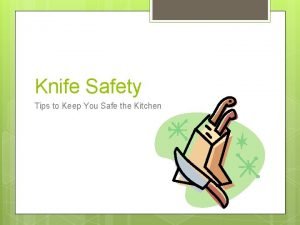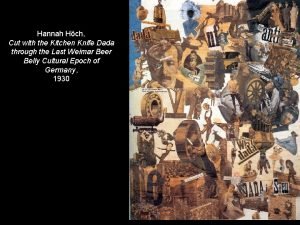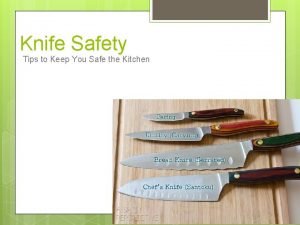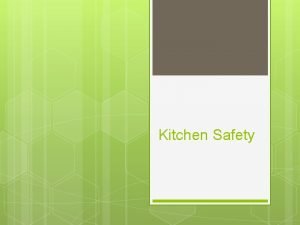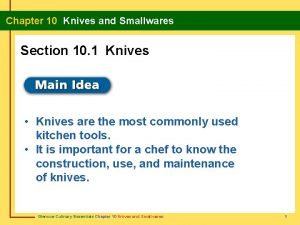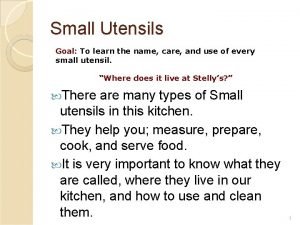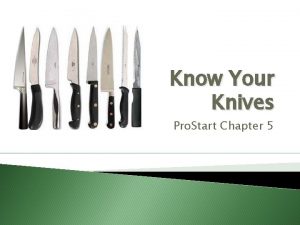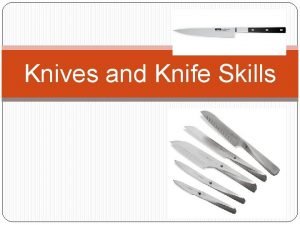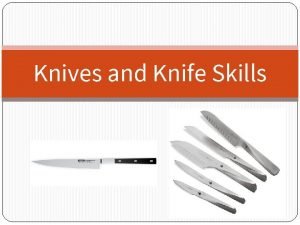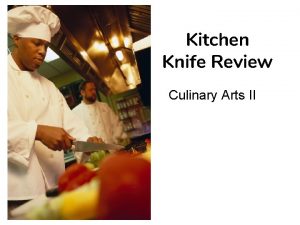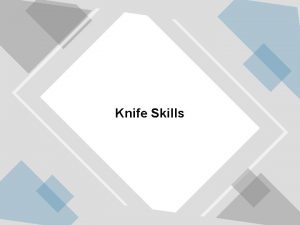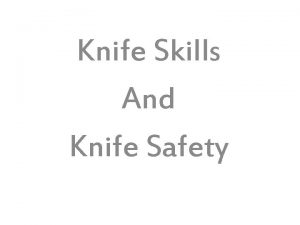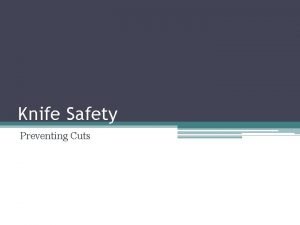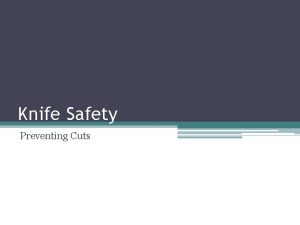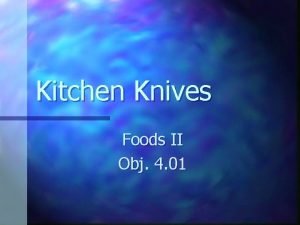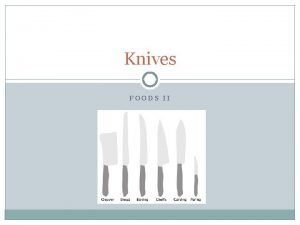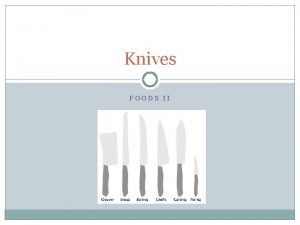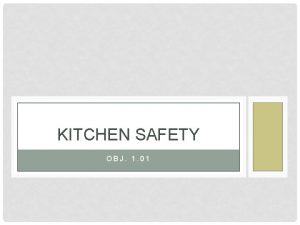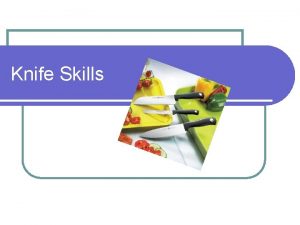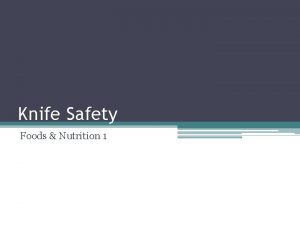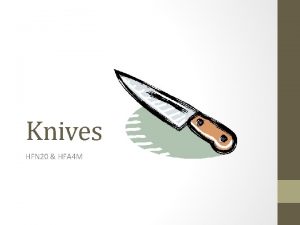Kitchen Knives and Knife Cuts Intro to Culinary





















- Slides: 21

Kitchen Knives and Knife Cuts Intro to Culinary Arts

Parts of the KNIFE

How are Knives Made? Every piece of commercial cutlery is constructed using one of two methods, forging or stamping. Forged blade knives are formed when heated bar steel is roughly shaped under a drop hammer, which compresses the steel under immense pressure. After the basic knife shape is formed, the blade goes through a grinding and honing process to form its final shape and edge. Forged Knives: ● Have a thicker and heavier blade than stamped knives ● Have a bolster between the heel and handle ● Are usually stronger and better balanced than stamped knives ● Are usually more expensive than stamped knives

Stamped blade knives are formed when a hydraulic press, or die, cuts the desired blade shape out of a flat sheet of steel, like a cookie cutter. Next, the blade blanks are sharpened through a multi-step grinding and honing process. Stamped Knives: ● Have a thinner and lighter blade than forged knives ● Do not have a bolster between the heel and handle ● Are not usually as balanced as forged knives ● Are less expensive than forged knives

Types of Knife Handles Commercial cutlery is available with a variety of knife handle types and constructions. Wood Handles Wood handled cutlery used to be very common, but has fallen out of favor with health inspectors due to food safety concerns. While very attractive and comfortable to use, wood handled knives are not as durable and can trap bacteria. Stainless Steel Handles Stainless steel handles are virtually maintenance-free. They are extremely durable and easy to clean. A very large or heavy knife with a stainless steel blade will likely be better balanced than a similarly sized wood or plastic handled knife. However, stainless steel handles do not provide a very good "grip" and can become slippery when wet.

Plastic Handles Plastic handles are now the most popular type of handle. They are often very easy to clean and hold up well, but can occasionally crack over time or when exposed to extreme temperature changes. Santoprene Handles Santoprene handles are a blend of synthetic rubber and polypropylene. This provides added slip resistance while increasing the durability of the knife.

Types of Knife Edges There are four common types of blade edges available on commercial cutlery. Straight Edge Sometimes called flat ground, a straight edge is the most common, and is formed by grinding the blade in a straight line so it tapers to form a razor sharp edge. Granton Edge Granton edge knives feature hollowed out sections running along both sides of the blade. When slicing meat, the grooves create a small air space between the product being cut and the knife to ease slicing. Granton edge knives are often preferred when slicing thin portions of poultry, roasts, or ham.

Serrated Edge Serrated edge knives may also be referred to as wavy or scalloped edge. Serrated edge knives feature teeth along the blade edge, which easily penetrate the tough outer crust or skin of the product being cut while protecting the soft inner part from tearing. Serrated edge knives are ideal for cutting bread and fruit. Hollow Ground Edge Hollow ground edges are created by grinding from just below the midpoint of the blade to form concave sides that come to a very thin cutting edge. Since this edge is so thin, it is more brittle and easily dulled. Hollow ground edges are not preferable for heavy cutting tasks, but are ideal for fine cutting such as skinning, preparing sushi, or peeling and slicing fruits.

Pearson Knife Skills for Chefs https: //www. acfchefs. org/ACF/Resources/Video_Library/Knife/AC F/Resources/Video/Knife/

The Right Knife for the Job The following descriptions should serve as a basic guide for some of the most common types of knives. Carving Knife (Slicer) Though there are many meat cutting knives, a meat carving knife is used to slice thin cuts of meat, including poultry, roasts, hams, and other large cooked meats. Carving knives are much thinner than a chef's knives, enabling them to carve thinner, more precise slices. Additionally, the pointed tip is perfect for cutting along a board, and it can be utilized in more ways than rounded blades.

Bread Knife /Serrated Bread knives are available in a variety of sizes from 7" to 10". Some feature an offset handle design to prevent the users' knuckles from hitting the cutting board. Bread knives may have a straight or slightly curved blade with a serrated edge (row of teeth) that's ideal for bread and hard rind fruits. Chef's Knife A chef's knife, or "cook's knife" is one of the most commonly used knives in a commercial kitchen. Available in sizes ranging from 6" to 14" (8" to 12" is most popular), the chef's knife features a wide blade with symmetrical sides that taper to a point. It is suitable for a wide range of tasks such as chopping, slicing, and mincing.

Cleaver A cleaver features a long, rectangular wide blade that is used to chop and cut through thick meat and bone. Cleavers are also ideal for opening lobsters. Chinese equivalent to a Chef’s knife. Used on vegetables. Butcher Knife/Cimeter Butcher knives and are primarily used to break down large pieces of meat into smaller cuts. Their blades are usually around 10” and are curved to create leverage to break through tough skin, cartilage, and small bones. They are also excellent knives for trimming fat off of meat. Utility Knife- Lighter version of chef’s knife. Used for light cutting, slicing and peeling.

Paring Knife Paring knives rate second in versatility after a chef's knife in a commercial kitchen. There are several common styles: Spear point paring knives are great for removing corn from the cob, breaking up heads of lettuce, peeling fruits and vegetables, cutting beans, and other similar tasks. Bird's beak or curved paring knives, also referred to as tournėe knives, feature a downward arching blade that makes peeling round fruit and garnishing a breeze. Sheep's foot paring knives feature a rounded tip with a straight edge. These knives are perfect for chopping and julienning fruits and vegetables on a cutting board.

Knife Care and Sharpening Dull knives are the single most common cause of commercial kitchen injuries. Because properly sharpened knives cut more easily than dull ones, workers can complete their tasks more quickly. Additionally, the product being cut can be returned to temperature-controlled storage more quickly for increased food safety! Here are some quick tips for maintaining cutlery: Regularly wash knives with warm, soapy water and dry them thoroughly. Hone knives regularly with a sharpening/honing steel. Keep knives sharpened with a knife sharpener.

Here are some quick tips for maintaining sharp cutlery: Regularly wash knives with warm, soapy water and dry them thoroughly. Hone knives regularly with a honing steel to maintain a knife's edge. Keep knives sharpened with a knife sharpener. Whetstone/sharpening stone Manual Sharpener

How to cut SAFELY The most important thing about knives is that they are sharp. (Less force = less likelihood of injury) Cut away from your body (diagonally) and use the pinch method of holding the knife. Use the claw technique. What does this mean? https: //www. youtube. com/watch? v=wq 0 FH 2 IGPAw Always cut on a cutting board. (make it nonslip with damp paper towel or dish cloth) The guiding hand holds and turns the food against the blade when peeling. Never put knives into a sink filled with soapy water – wash and dry separately!

Common Knife Cuts • Coarsely Chopped: large sized, irregular pieces • Chopped: medium sized, irregular pieces • Minced: small sized, irregular pieces • Finely Minced: extra small, irregular pieces • Sliced/Rondelles: round cuts, cut crosswise, ¼ inch thick • Lozenge: diamond shape, used for garnishes

Precision Knife Cuts • Medium Dice: ½ x ½ inches • Batonnet (bat-tow-nay): ¼ x 2 inches • Small Dice: ¼ x ¼ inches • Julienne: • 1/8 x 2 inches Fine Julienne 1/16 x 1/16 x 2 • Brunoise(brewn-whaz): 1/8 x 1/8 inches


Other Cuts • Cookies/Crackers – Crushed (use rolling pin or food processor) • Herbs: – Snipped (put herbs in cup and cut with kitchen shears) – Chiffonade (stack leaves, roll like a burrito and then slice)

Chef Carrie Knife Skills https: //www. youtube. com/watch? v=b. Zbp. Eqv 7 D f. U&t=3 s
 Basic knife cuts chart
Basic knife cuts chart Kitchen knife safety tips
Kitchen knife safety tips Raoul hausmann collage
Raoul hausmann collage Knife safety in the workplace
Knife safety in the workplace Kitchen knife safety poster
Kitchen knife safety poster Latin word for camera
Latin word for camera Well obviously we have a
Well obviously we have a In the kitchen or at the kitchen grammar
In the kitchen or at the kitchen grammar In the kitchen or at the kitchen grammar
In the kitchen or at the kitchen grammar Section 10-1 knives
Section 10-1 knives Youtube.com
Youtube.com Hand tools and small equipment
Hand tools and small equipment Knife used to cut thick sandwiches
Knife used to cut thick sandwiches Fluid energy mill principle
Fluid energy mill principle They salute with both hands now
They salute with both hands now David low they salute with both hands now
David low they salute with both hands now Medford knives eoc
Medford knives eoc Allied powers
Allied powers Open benefit sonoco
Open benefit sonoco Tou knives
Tou knives Nutrition for foodservice and culinary professionals
Nutrition for foodservice and culinary professionals Nutrition for foodservice and culinary professionals
Nutrition for foodservice and culinary professionals
